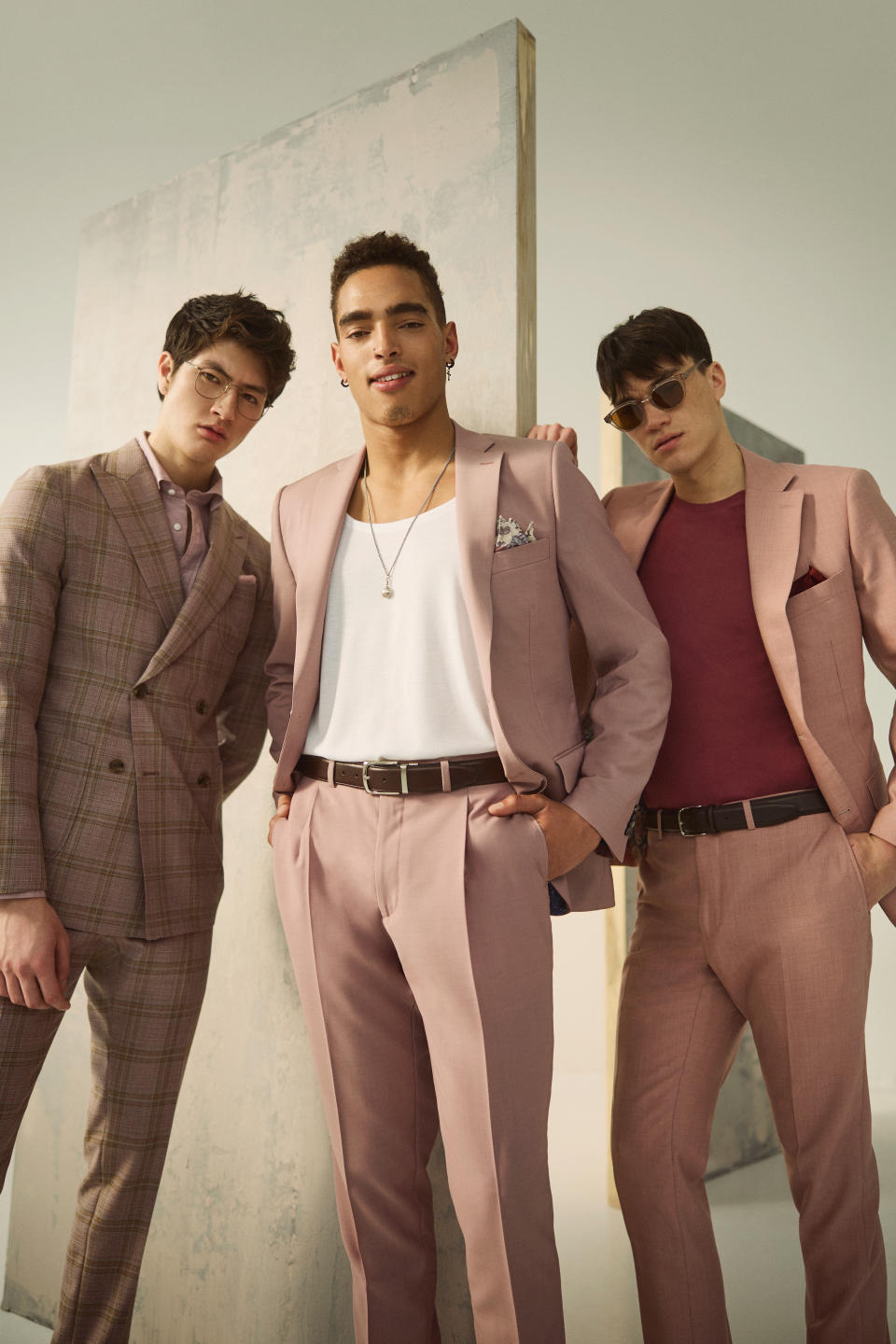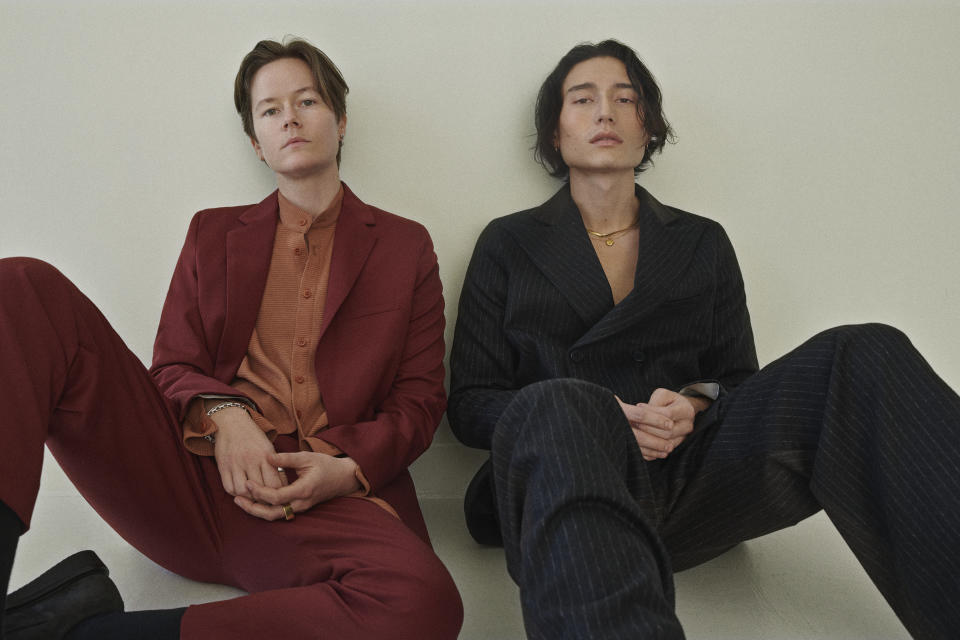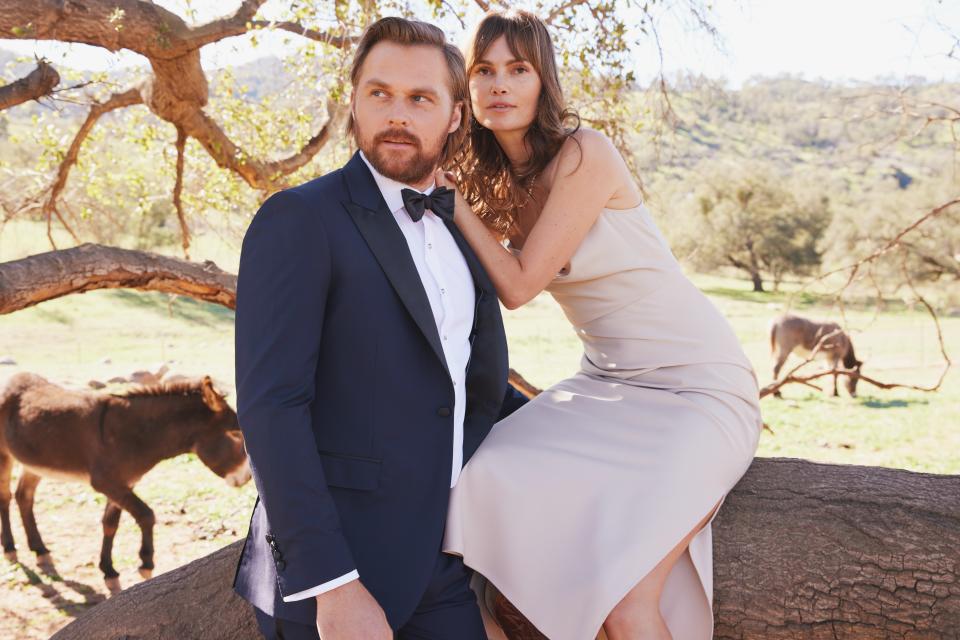The Suit Is Back for Weddings, Office — but Bolder and Wilder

Wedding season is upon us.
This year marks a return to normalcy for many parts of the world and parts of the U.S., and weddings have returned in a big way.
More from WWD
Made-to-measure suiting companies and custom ateliers have agreed that the weddings and events business is helping sales eclipse 2019 and they are on the road to all-time highs.
Vancouver-based custom apparel retailer Indochino said 2019 was a growth year for the company and included the beginning of their relationship with Nordstrom, and that new and existing clients buying suits for their weddings, events or return to the office has pushed business to exceed 2019 and be above their forecast for 2022 year-to-date.
Custom menswear retailer Alton Lane agreed, saying that February 2020 was its best February up to that point and capped off its best year in business.
But with stores temporarily closing their doors due to COVID-19, the retailers had to pause and in some cases scale down in order to stay alive.
“Our demand is contingent on celebrations, weddings, graduations, face-to-face meetings,” says Fokke de Jong, founder and chief executive officer of Amsterdam-based men’s suiting and fashion brand Suitsupply. “Our business was very impacted. After 2019, we were focused on scaling down our business.”

Courtesy Photo
COVID-19 and the global lockdowns enforced to prevent the virus’ spread took many things from society for several months, like the five-day, in-office work week, the average school day, film premieres and nightclubs. It also hindered fine dining, retail shopping, church services and gym workouts.
One could argue that weddings suffered the most during the pandemic. Couples had to postpone their 2020 wedding plans for a full year or indefinitely, and for many, without a refund.
Now de Jong’s company and many suiting brands are experiencing what he describes as a “pent-up effect” from men tired of sweatpants and casualwear. In regards to 2019 compared to 2022, he says, “If you thought business was busy [in 2019], I think it’s busier now.”
“I think the biggest issue in 2022 versus 2019 is the time and effort we spend on recruitment, hiring and onboarding people,” he continues. “There are many people saying the search for talent is tough, but we’ve been successful in finding good people. Even though we were making a massive loss we have kept all of our suppliers and partners that we have.”
Indochino vice president of retail Dean Handspiker and Alton Lane cofounder Peyton Jenkins both noticed that men are taking more risks with their suit options. Handspiker says the black tuxedo and black and navy suits are still the bestsellers, but more men are experimenting with color.
They also continue to see a slim fit, despite suiting trends by luxury and contemporary men’s labels moving into a more leisure fit, and updated takes on 1990s suiting from brands like Fear of God, Tiger of Sweden, Casablanca and Umit Benan’s B+ line, among others.
Ash Owens recently launched its post-gender tailoring label Suited Atelier and believes that men’s more adventurous expression is a result of COVID-19.
“I do think that it’s a large part because of the pandemic,” Owens says. “I think a lot of people did work on themselves in a lot of ways and feel more comfortable standing out and less tethered to society’s norms, for lack of a better expression. I feel like people questioned a lot so it’s less about fitting in. When it comes to trends, I feel Gucci has had an impact on that 1960s, 1970s vibe and people being interested in a wider lapel and a generous fit.”
Owens moved to New York City to study at Parsons School of Design and apprenticed with a tailor that worked with Thom Browne and Duckie Brown, among others. They started the website Grandpa Style and Suited Magazine in the last decade prior to launching Suited Atelier this year.

Dominik Tarabanski
“When it comes to gender, specifically gender expression, it has evolved so much in the last few years, because we have legalized gay marriage,” Owens says. “There are a lot less rules and a lot less conservative style. When it comes to weddings you can do a colored tuxedo in different tones. I’m working on a suit for a client that wants a goth cowboy vibe and I feel that’s just creativity in those spaces, because you’re already questioning norms and now you feel you can really have fun with it.”
Owens produces suits for men and women, transgender and non-binary clients and encourages its clients to go with a bespoke suit for a more precise fit.
“Thinking about queer bodies is totally different in a lot of ways, because of how people want to present,” they said. “What do they want to present and how they want to. It’s an important part of working with queer people when it comes to suiting. Somebody who has a larger chest may want to come off more masculine so we leave the waist looser or approach the fit for how you want people to see them.”
Owens found that their clients are looking to stand out wanting textured suits, patterns and prints; wider lapels; longer, looser fits, and unique colors, like champagne pink.
“Sage, tan and softer pastels have been a surprise hit,” Handspiker adds. “We’re seeing a lot more in wool/linen and silk/linen blends.”
Jenkins adds, “Our weddings and events business, while not the lion’s share, it is a sizeable portion and one that we’re grateful for. We’re not seeing men say I need a navy suit or black tuxedo but the guardrails of style consistently across the broad expanding a bit. They’re going out of the comfort zone for his wedding and taking that into his work environment.”
Jenkins wore a navy and royal blue seersucker jacket with mother of pearl buttons in the Zoom call interview for this story, and said the style is one way men are expanding those guardrails. Most shoppers are adventurous but are dipping into the water in different ways.
For instance, some opt for custom linings for personalization, matching team colors if the groomsmen played together on a team, and loose rules like following a color scheme but being free to wear notch or peak lapel jackets and different suit cuts and linings. Other men go bold in royal blue tuxedos, deep red and burgundy jackets and dinner jackets in bold colors.
“There’s more movement to double-breasted jackets,” Jenkins adds.

Courtesy Photo
Alton Lane is currently the exclusive partner of Anthropologie’s Bhldn wedding destination. “The men’s side of the wedding industry has long been an opportunity for expansion,” Jenkins says. “Bridal has such a focus and not too many magazines are for just the groom.”
Handspiker and Jenkins also found opportunity in groomsmen, seeing the party as a way to introduce more men to their businesses. Handspiker adds that he’s bullish on this year continuing its pace and expects groomsmen will return for more formal and casual looks.
But does this increased demand for tailoring signify a change in menswear? Male guests at the Met Gala in May 2022 were much more expressive than in previous years. There were far fewer classic black tuxedos compared to capes worn by Kid Cudi and Gunna; kilts on Oscar Isaac, Travis Barker and Russell Westbrook; new styles by Bad Bunny in Burberry, Alton Mason in Prada, Odell Beckham Jr. in Cactus Plant Flea Market, Evan Mock in Head of State, Sebastian Stan in Valentino, and Jordan Roth in a Thom Browne dress, among other looks.
Even on the NFL Draft red carpet, new draftees experimented with bright colors, patterns and autobiographical details to celebrate the momentous occasion.
“The Met Gala is an interesting one and celebrity culture in general in terms of its effect on menswear,” Owens says. “I think back to when the Americana vibe was everywhere and the Italian dapper style, but now I feel it’s a little more mood and less classic and traditional and feels more specific to the person.”
They also mentioned music artist Lil Nas X’s style and expression, too, saying, “there’s such a range and influence from queer culture and influence from ways people want to be perceived and people can be perceived different and people don’t have to look the same, and I really enjoy that.”
Jenkins recognizes that his customer predominantly prefers a more fitted suit, but also sees that comfort shifted how men want their suits and shirts to fit.
“I don’t expect higher waists and wider legs for our customer, but I think that within menswear for sure it signifies a broadening of acceptability,” he says. “For the Met, it’s been a while since we’ve had that — it’s a welcome back moment. In that environment it’s OK to surprise and delight. We never focus too much on traditional fashion. The style red carpet doesn’t affect that a whole lot, but where it does take effect is its broadening the margins that our customer feels he can comfortably play in.”
He mentioned David Beckham, soccer star and one of menswear’s longtime style icons, as an influencer for tattoos and how many men saw tattoos as less taboo and more acceptable because of Beckham.
“If he’s 10 percent more open about going a little bolder, you get more compliments and that compliment is a cycle that makes you more aware,” he says.
Sign up for WWD's Newsletter. For the latest news, follow us on Twitter, Facebook, and Instagram.

